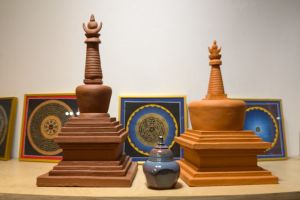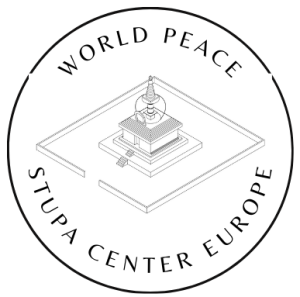Enlightenment Stupa
What is a Stupa?
A stupa is an important buddhist symbol for peace and enlightenment. It serves as a beacon of hope, reminding us that every person carries the potential for peace and enlightenment within. The pinnacle of the stupa acts as an ‘antenna,’ transmitting its positive message into the world. Inside the heart of the stupa, a prayer wheel spins with all the teachings of the Buddha. The base of the stupa offers a space for quiet reflection, where around 20 people can gather. The stupa will be open to the public and is designed to welcome many visitors.
Four continents
This stupa is one of four monuments in Tarthang Tulku’s World Peace Prayerwheel Stupa Project. Similar stupas are being built in Brazil and Japan, and an Interfaith Prayerwheel is being constructed in Israel. All four monuments are dedicated to contributing to world peace. The stupa will serve as a place for ceremonies focused on peace, and you will have the opportunity to dedicate a ceremony to a loved one.
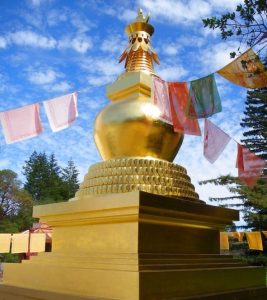
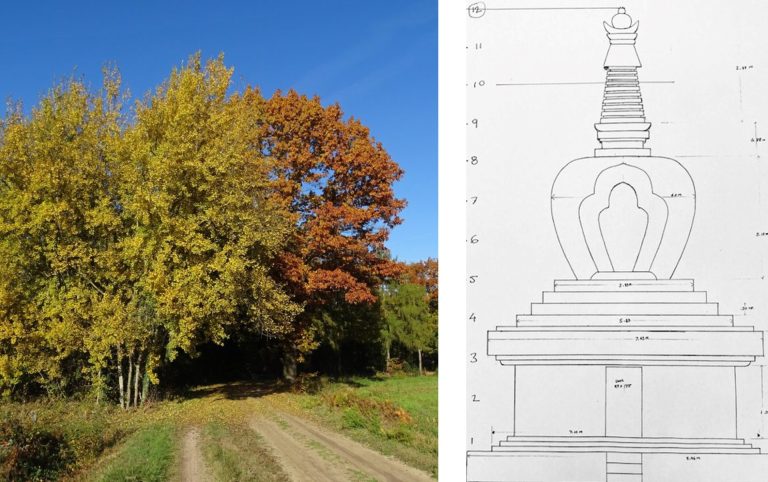
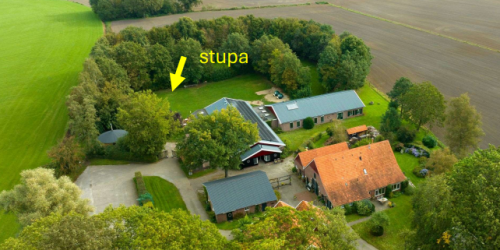
The Enlightenment Stupa in Buddhist History
From the books ‘Enlightenment Stupa’ and ‘Crystal Mirror 12 The Stupa: Sacred Symbol of Enlightenment’
“Out of compassion for beings confined within the small world of the self, ignorant of the beauty of their inherent enlightened nature, the Awakened Ones have always found ways to open doors to understanding. Their offerings may take the form of sacred texts, art, images, or even entire monuments that convey teachings through shape and proportion. The spark that enlightens may be encoded in the syllables of mantra or even within the shape of a single letter. Embedded in all sacred symbols – in sound and laguage, in sacred teachings and images – these codes transcend the limitations of language to activate enlightened knowledge.
The stupa is part of this heritage. Embodiment of the inconceivable compassion of the Buddha, its structure represents the eightfold path, the six perfections, the stages of enlightenenment and the luminous qualities of Dharmakaya. For those who can read these symbols, the stupa illuminates the path that tranfsforms poisons of greed, hatred and confusion, into catalysts for enlightenment.” (Enlightenment Stupa p. 1-2)
“Sutras describe the stupa’s power to support realization and promote peace and harmony for all beings as well as the natural environment. Mindful of these benefits, kings and patrons through the centuries have built stupas to honor the memory of the enlightened one, enshrine relics, ensure the longevity of the Dharma, and promote the welfare of their people.” (Enlightenment Stupa p.2)
“When properly constructed and empowered, stupas bring into the universe energy of peaceful virtue and strength that beings of all realms, visible or invisible, become happy, and natural forces become balanced and stable”. (Enlightenment Stupa p. 5)
“At Bodh Gaya, shortly after enlightenment, the Buddha Shakyamuni gave hair and clippings of his nails to the traveling merchants Trapusa and Bhallika, who had offered him honey and cakes. Asking that these relics of his body be placed within a stupa, the Buddha demonstrated the form of a stupa by folding his robe four times for the base, inverting his almsbowl and placing it upon the robe for the dome, and placing his staff upon the bowl for the pinnacle. When the merchants returned to their homeland, they built stupas to enshrine the hair and nail relics they had received. Claimed by several Buddhist traditions, these stupas, the first associated with the corporeal relics of the Buddha Shakyamuni, have been variously located in Afghanistan, Sri Lanka and Burma.” (Enlightenment Stupa p.8-9)
“This practice follows the Buddha’s instruction given in his final teaching in the sala tree grove near Kushinagara, when he named the four types of beings worthy of stupas: Buddhas, Pratyekabuddhas, disciples (Arhats), and Chakravartin (virtuous and powerful) kings. Wherever monks traveled to disseminate the Buddha’s teachings, they built stupas to mark the pilgrim’s route and consecrate sacred spaces for practice and realization. Stupas became the spiritual focus of every monastic center.” (Enlightenment Stupa p. 13)
“The great master [Nagarjuna] described eight forms of stupa that symbolize ways the Buddha demonstrated the Dharma: birth in Lumbini, enlightenment at Bodh Gaya, turning the wheel of the Dharma for all beings at Sarnath, establishing the Sangha at Rajagriha, demonstrating boundless emanations of enlightenment through the great miracle at Shravasti, demonstrating control over his lifespan at Vaishali, and Parinirvana at Kushinagara.” “Honoring the eight stupas, looking upon them with reverence and reflecting on their significance, practitioners today can enact the ancient practice of pilgrimage the Buddha prescribed for his disciples. Those who construct, beautify, and care for stupas are also blessed, for this work is highly meritorious.” (Enlightenment Stupa p. 14-15)
“It is said that the shape of the stupa manifests to support our awakening, and that even those who lack understanding of its meaning receive these blessings subliminally. The stupa’s form has been described as representing the structure of the path to enlightenment, the interplay of the five elements, and many further aspects of the knowledge transmitted through the Buddhist traditions.” (Enlightenment Stupa p. 19)
“Each stupa has a base of four steps, representing Dharmadhatu, at once the foundation and the context of the whole path to enlightenment. Upon this base is the lion throne, emblem of the four fearlessnesses. From the lion throne arise the four four-sided steps of the terrace, equated with the four foundations of mindfulness, the four genuine restraints, the four bases of supernormal powers, and the four spiritual faculties. Upon the last step rests the base of the curved vase of the stupa. The base relates to the five strenghts and the vase to the seven limbs of enlightenment. Above the vase is the support for the harmika, which represents the noble eightfold path. Deep within the stupa’s upper part is the obelisk, or heart-wood; Filled with precious relics, it symbolizes the ten knowledges, unique to a Buddha. The harmika itself stands for the four enlightened wisdoms and the four great deliverances. The thirteen wheels above the harmika represent the ten stages of the Bodhisattva path and the three vajrapada aspects manifested by a fully enlightened Buddha. The parasol surmounting the thirteen wheels symbolizes the ever-available protection of the Buddha’s compassion. The sun, moon and flame atop the parasol represent the wholeness of all existence in the unified field of Dharmadhatu.” (Enlightenment Stupa p. 21-22)
“More than 2500 years ago, the Buddha Shakyamuni demonstrated the form of the stupa and explained the merit of builiding and honoring this sacred symbol of enlightenment. Guided by the scriptures, masters of all Buddhist traditions have given detailed instructions for the construction and empowerment of stupas. While stupas built in different cultures and at different times may vary in size and shape, they all have the same essential features prescribed by the Buddha. They manifest the radiance of Dharmadhatu, and the power of their blessing continues in the world.” (Enlightenment Stupa p. 25)
“In Tibet, where even the smallest monastery would build a stupa in order to protect the lad and invite the blessings of the Dharma, the great stupa at Gyantse is especially renowned as the Stupa of a Thousand Images. A masterpiece of architecture and art, it is perhaps the largest stupa ever built in the form known as ‘Many Doors to the Dharma’. Several stupas in Tibet are said to have been built by Ashoka, including the Cagri Odbar (lCag-ri-‘ od-bar) Chorten in my [Tarthang Rinpoche’s] native region of Golog. This stupa, which rises eighty feet high from a base a hundred feet in diameter, is now almost completely covered with mani-stones and other prayers and symbols that devout practitioners have offered there since ancient times.” (Enlightenment Stupa p. 29)
“It is said that wherever a stupa remains standing, the light if the Dharma will continue to shine. The stupas that once flourished in Khotan and other kingdoms of Central Asia, in Afghanistan, Kashmir and elsewhere may lie in ruins, and many thousands of stupas may have fallen into disrepair in recent times, but hundreds more are preserved and honored. It is said that as long as the Sangha remains active and the Dharma is supported, stupas will continue to be built and maintained with the highest respect and veneration. For the welfare of all humanity, it is my deepest wish that this sacred tradition continues.” (Enlightenment Stupa p. 29-30)
“A symbol of bodhicitta, the enlightened heart of the Buddha, the stupa can also be understood as an embodiment of Dharmakaya, the formless, immeasurable, uncreated, and unchanging nature of enlightened being. Externally, the stupa is a reminder of the Buddha, Dharma and Sangha; inwardly it is the source of profound peace and tranquility. Transformed into symbol through the alchemy of proportion and shape, the stupa communicates directly to subtle levels of consciousness, illuminating awareness and calling forth the potential for enlightenment. When constructed and empowered according to instructions in traditional texts, the stupa becomes a victory banner, fusing the inner realm of experience with the outer cosmos, merging the innermost heart of enlightenment with the infinite field of enlightened activity.” (Enlightenment Stupa p. 39)
“Symbol of universal and unchanging Dharmakaya,
The Stupa is a banner of victory in the midst of samsara’s turmoils,
A point of Balance for the cosmos
And a place of refuge for living beings.
Whoever honors this Stupa with devotion and offerings
Will develop a wholesome consciousness receptive to beauty and the joy of inner freedom.
These blessings will continue to operate in the world and
Will manifest to all being throughout the natural realms” – Tarthang Tulku (Enlightenment Stupa p. 40)
“Although the physical form of the Buddha is no longer with us, the Stupa offers us a way to connect with the lineage of Buddhas and Bodhisattvas through Sambhogakaya manifestations of Enlightenment. Empowered by relics, mantras and images of the Enlightened Ones, the Stupa has a way of relieving the pain of all who come into contact with it and replacing it with a sense of fullness and joy. By virtue of its form, its composition and proportions, it also has a way of reshaping the forces of chaos and destruction in or natural world and bringing them into harmony and balance. In our tradition, we look to the stupa for healing and protection for our entire planet as well as for living beings.” (Enlightenment Stupa p. 81)
“Approaching the Stupa with reverence, taking refuge, praying and making offerings brings great merit. These virtuous acts will protect against negative karma and hasten success on the spiritual path. Please dedicate the merit of your practice at the stupa to your parents and to the longevity of the Dharma in this universe.” (Enlightenment Stupa p. 83)
“Profound symbol of Dharmakaya, the Stupa offers a place to practice, to confess wrongdoing, to make offerings, to take or renew vows, to enter a new life, and to commit yourself to the path of liberation. Practice at the Stupa opens new ways of understanding and realization and invites a flow of blessings. You can take these blessings back with you into daily life, where they will work from within to transform your way of being.” (Enlightenment Stupa p. 129)
“Unique among all forms of sacred architecture, the stupa is the quintessential symbol of enlightenment, the primordial sacred structure for all Buddhist traditions. More than a symbol, the stupa is a powerful catalyst for activating past, future and present blessings simultaneously. Its form, luminous and pristine, communicates directly to subtle levels of consciousness and calls forth the potential for enlightenment. While the stupa has historically appeared in different shapes, alls of its forms connect the inner realm of experience with the outer physical cosmos. Constructed and empowered according to the sacred texts, the stupa becomes a gateway joining inner and outer, merging the innermost heart of enlightenment with the infinite Dharmadatu.” (Crystal Mirror 12; The Stupa: Sacred Symbol of Enlightenment p. xxi)
“The stupa has long been a potent Buddhist symbol, a pure manifestation of enlightenment. Constructed in accord with universal principles and empowered with the knowledge coveyed through the Buddhist lineages, stupas promote harmony and balance in the world. Magnified many times over by the relics sealed within, their ability to defuse the forces of chaos and negativity can ease the ills of body and mind, heighten awareness, and avert natural disasters. For those attuned to their significance, stupas can directly transmit the power of enlightenment.” (Crystal Mirror 12; The Stupa: Sacred Symbol of Enlightenment p. 3)
“Consecrated by the blessings of the enlightened lineages, the stupa transforms offerings into merit that opens the spiritual path and awakens the aspiration for realization. Providing no place for the ego to take hold, the stupa is a pure receptacle for devotion and prayer directed to peace and harmony among living beings. It promotes order in nature and in the wider cosmos, protecting from disasters and healing the disquiets of the human heart. Within its range of blessings, suffering dissolves, and compassion begins to emerge. From compassion arises Bodhicitta, the heart of enlightenment.” (Crystal Mirror 12; The Stupa: Sacred Symbol of Enlightenment p. 3)
“Now, as in ages past, the stupa is a major focus of revitalization, an enduring symbol of universal harmony and peace, and a vehicle for spiritual transformation.” (Crystal Mirror 12; The Stupa: Sacred Symbol of Enlightenment p. 42)
“In the deep and broad vistas of the Mahayana, the stupa is closely associated with mandala, the pattern through which the primordial energy of enlightenment takes on shape and form and enters the range of human perception.” (Crystal Mirror 12; The Stupa: Sacred Symbol of Enlightenment p. 71)
“
